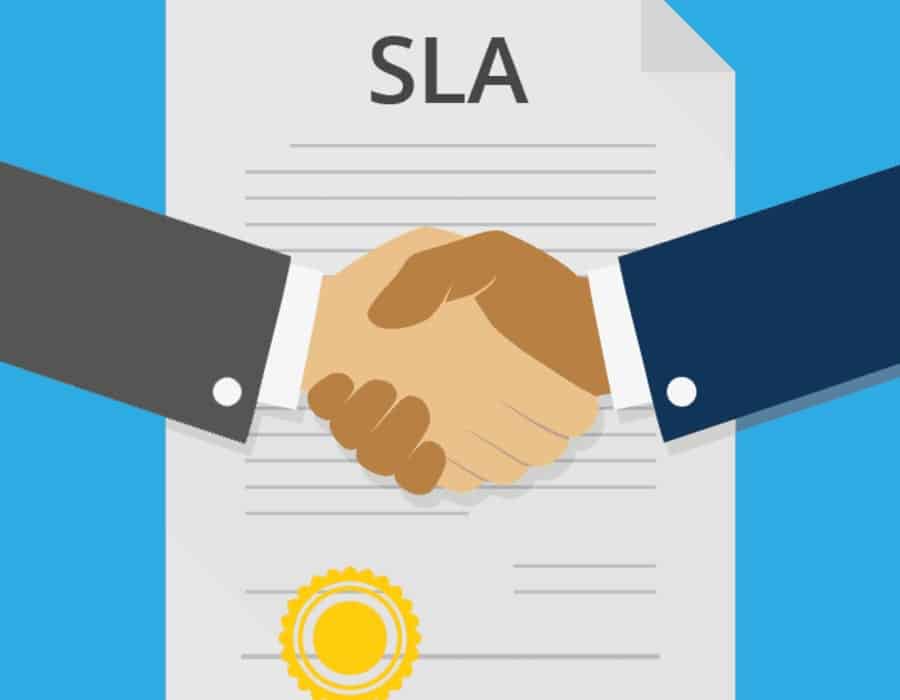A service level agreement (SLA) is a set of promises made by the supplier of IT services to their customer. It is a legal agreement that sets the expected level of service the customer will receive and usually includes penalties if those service levels are not meant.
An SLA will also contain a detailed description of the services that will be delivered and information about how those services will be delivered.
Primary Types of SLAs
Most SLAs fall into one of three different categories:
- Single Service Agreements
- Customer-Level Service Level Agreements
- Multi-Level Agreements
Single-service agreements are used when a company provides a single IT service to a customer, even if that service is provided to multiple departments. If a customer needs multiple services, the best practice is to have a separate SLA for each service. This avoids confusion when multiple services are being purchased.
Customer-level SLAs are most common when a single customer is contracting with a cloud service provider, and the customer will be using multiple, but related services. Each service will have a separate section of the SLA.
Multi-level agreements are a combination of a single-service level agreement, a customer level agreement, and a corporate-level agreement. This is used when a large organization contracts for IT services, and this agreement covers service issues for each “customer” inside of the large organization.
Do You Need an SLA?
Yes. SLAs are critical because they provide both the legal framework for the relationship, and they outline the expectations for both sides about the acceptable level of service. IT services are complex, and sometimes abstract.
The terminology can be confusing when the customer and the provider are using the same terms to mean different things.
The SLA helps both the customer and the provider move forward with confidence and clarity.
SLA Best Practices
One of the most important SLA practices is to make them clear. Because they are legal documents, any confusion may lead to expensive litigation. Beyond making sure that SLAs are written so they can be read and understood, there are two other important best practices:
Use SMART Goals
You want the SLA terms to be measurable because that provides an objective standard that both sides can understand.
You should use the SMART goal framework to create SLAs. This means that every service needs to be described in a way that is:
- Simple
- Measurable
- Achievable
- Relevant
- Time-bound
Align with Desired Outcome
The provisions of your SLA need to be tied to the desired client outcome. There is nothing worse for a relationship between a provider and a customer than a situation where the provider is meeting all of the metrics of the SLA, but still failing to provide the customer with the outcomes they want.
Abstract goals aren’t good enough. Every service needs to be aligned with a specific customer-desired outcome.
Key Provisions
Because every customer will need different services and have different goals, each SLA will be slightly different. However, every SLA should have three provisions:
- Uptime
- Remote Hands Team
- Transparency
Uptime
Nothing matters to the customer as much as uptime. A lot of time needs to be devoted to describing what level of uptime reliability is acceptable, how uptime is measured, and what the consequences are of failure to meet uptime reliability standards.
The numbers in this section matter. Having an uptime of 99% is not the same as an uptime of 99.9% or 99.99%. Every digit matters when calculating uptime.
Off Hours Troubleshooting
What happens if something goes wrong after normal business hours? The SLA needs to make provisions for support and remediation outside of regular business hours.
In agreements between data centers and customers, there is usually a provision for a remote hands team. This is a team of qualified IT personnel who can take care of unexpected issues.
Transparency
Both sides need to know how to verify the SLA standards are being met. A guaranteed metric is meaningless unless the customer can see how well the provider is living up to their promises for themselves.
Transparency is especially important in the areas of uptime and network traffic.
SLAs are not a nuisance. They are the best way to ensure a strong and effective partnership between providers and customers.

